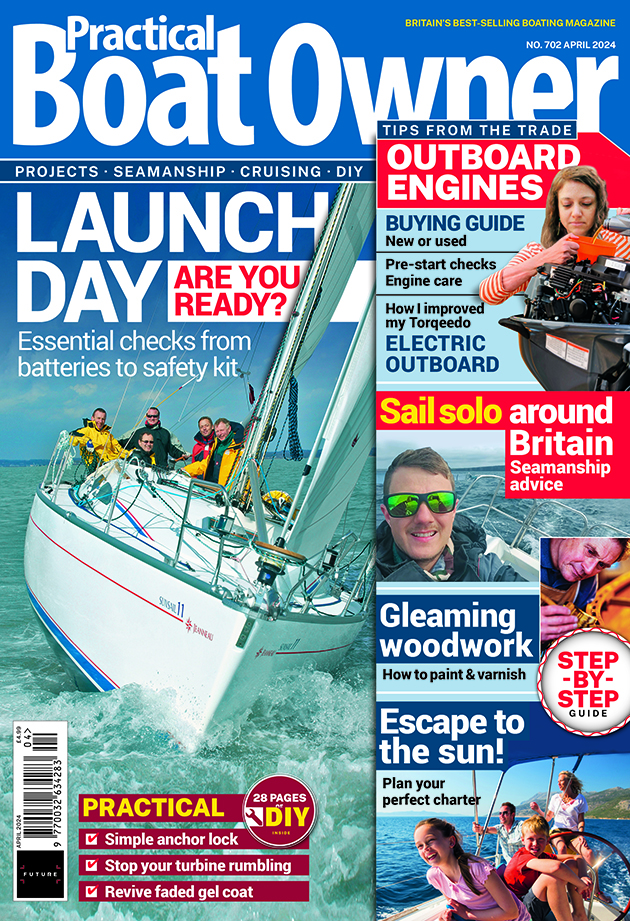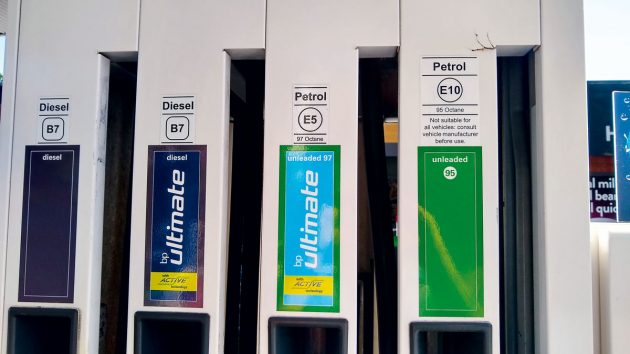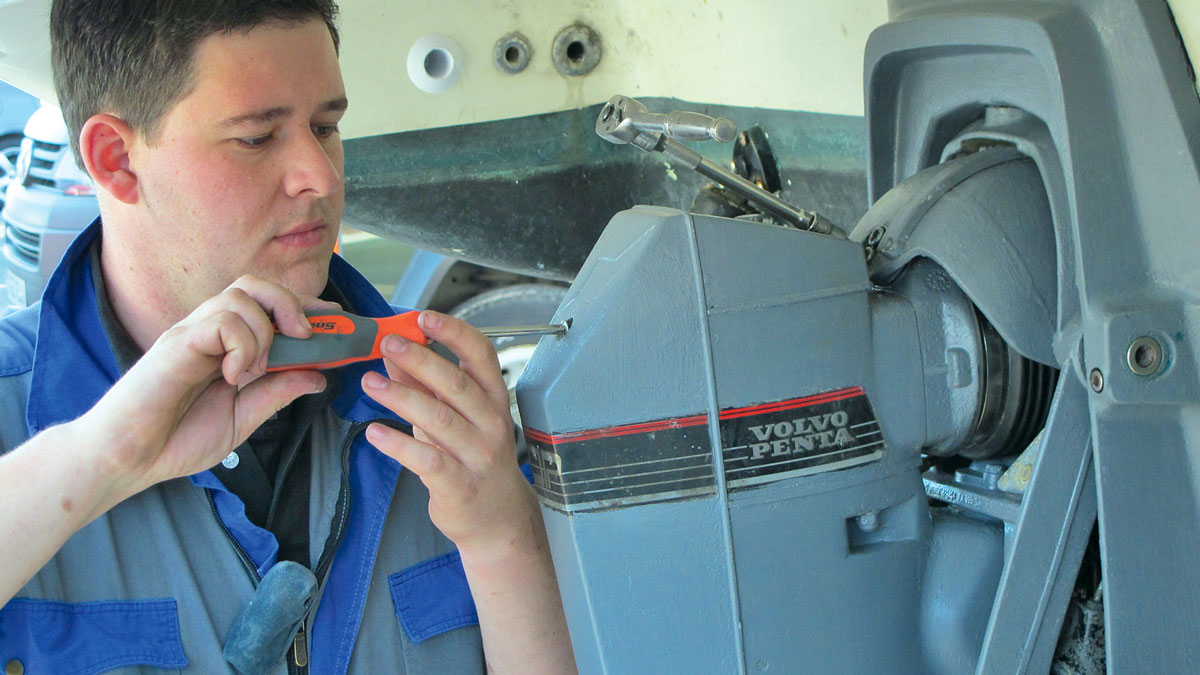E5 and especially E10 petrol requires much more ‘fuel husbandry’ than older, ethanol-free petrol blends, as Jake Frith has discovered
Managing E5 and E10 petrol problems in outboard engines
September 2021: while most of the population was concerned with breaking their way out of a global pandemic, the UK quietly switched to E10 petrol as its default garage forecourt blend.
Most motorists, or at least most of those with cars built after the turn of the millennium didn’t notice the change, but sporadic users of small engines – be they lawnmowers, chainsaws or outboard motors – started to encounter some issues straight away.

Ethanol-blended petrol causes problems in small outboard engines, like having to wipe up a gooey mess from a stored boat’s fuel tank. Credit: Jake Frith
E10 petrol contains 10% ethanol, and you guessed it, E5 contains 5% ethanol.
Ethanol is a form of alcohol, which like other forms of alcohol can be produced from crops and added to fossil fuels to reduce their carbon footprint.
This is why governments worldwide have legislated for adding successively larger quantities of ethanol to forecourt gasoline to help meet climate targets.
Fierce debates about the huge swathes of land this practice takes out of food production are not within the remit of a boating magazine.
Ethanol issues causing E5 and E10 petrol problems
What is within our remit is the reality that ethanol-blended petrol in small outboard motors presents or exacerbates several medium- and long-term reliability issues that were all much more manageable in older ethanol-free petrol.
Ethanol is hygroscopic. As anyone who has enjoyed a gin and tonic will attest, water and alcohol do mix very nicely, thank you.
Hygroscopic means more than this though, and the ethanol in E10 or E5 petrol will pull moisture from the atmosphere, over time.
VERY small quantities of water in petrol in our relatively low-tech marine engines are not a major disaster, with the engine downing it in one with little complaint.
However, in a scenario where there is a damp atmosphere, the fuel is left unused for some time and there is air present with the fuel (as in a half-full fuel tank or carburettor float bowl), the fuel can reach a point called ‘phase separation’.
This is where the fuel breaks down into individual layers, one containing the (highly corrosive) water and ethanol mix, and floating on top of it a layer of reduced octane petrol, now depleted of its ethanol.
Outboard engines will flatly refuse to run on either of these unpalatable fluids.
Ethanol is an effective solvent.

The ethanol in E10 petrol has spectacularly eaten this transparent plastic liner of this external tank fuel line. Credit: Jake Frith
More accurately put, ethanol is a different solvent from petrol (which is also a solvent of sorts).
This presents two possible issues.
Firstly it means that engines that are switched over onto ethanol blends from ethanol-free blends have their tanks, lines, filters and fuel systems deep cleaned by the ethanol, and any removed deposit or material can find its way into the filters or carburettor jets, potentially causing a breakdown.
Secondly, and particularly with older engines built long before ethanol was on the radar, some non-ethanol-compatible plastic or rubber parts and hoses can be slowly eaten away.
Apart from the potential breakdowns due to hose failures and leaks, the dissolved chemical gunk from the partially eaten hoses can find its way into the engine where it is liable to block filters or worse.
So why’s my car OK with this stuff?
Modern petrol road cars don’t suffer from ethanol blend problems anywhere near as badly as our boats as they typically have sealed, rather than air-vented tanks and fuel injection systems that are also airtight.
The hygroscopic issue is exacerbated in boats stored on or near the water due to the limitless amounts of humid air that the fuel can pull in from the atmosphere through a vented system.
Ethanol has been on the radar of car manufacturers for two decades, so the rubber and plastic fuel system parts have been engineered to cope with it for years.
Most cars are also not left standing for months at a time so they have a good throughput of fuel, so usually these issues simply don’t ever manifest in our cars.
The solutions to E5 and E10 petrol problems
The good news in all this is that all of the issues around ethanol-blended fuel storage are manageable.
Indeed, for some heavy users such as sailing club rescue boats or charter RIBs, it’s a non-issue because the throughput of fuel in the boats, just like in most cars, is high enough that even the higher ethanol E10 petrol never sits around long enough to become a problem.
If this is the case for you, crack on and enjoy the savings of the cheapest, nastiest supermarket E10 petrol you can find!
For less frequently used boats, here are some solutions I’ve found which all work to some extent, often even better when used in combination.
Keep records
Knowledge is power when it comes to successfully running boat engines on ethanol-blended petrol.
It’s now more important than ever to keep records of what fuel went into which tank or engine.

The Frith collection now sports tags covering which fuel went in which engine and when. Credit: Jake Frith
I tend to mark it with a permanent marker on labels attached to external tanks, or to engines that have integral tanks, then wipe it off with thinners and update it when I refuel.
This is what has allowed me to get a rough handle on what works and what doesn’t, and for how long, which has proved as useful for reliably operating boats as it is for writing magazine articles about it.
Don’t store any petrol
If you aren’t going to store a partial tank of fuel in the boat or outboard tank, and your engine hoses etc. are happy with ethanol then you aren’t going to encounter problems using E10.
In boats though, we want to have a good supply of fuel in excess of that required for the planned trip, for obvious safety reasons, so we can’t reasonably calculate the exact amount of fuel we will need and only fill up with that.
This means it’s quite common for a boat to sit with a partially full tank of fuel.
Topping off the fuel tank at the end of a trip could mean that there’d be relatively less air accessing our fuel, mitigating the issue somewhat, but this is a risky strategy as it risks endangering the future usability of yet more fuel.
Throwing away ‘off’ fuel is no fun for the environment or our wallets.
But if you or anyone you know has a petrol car, there’s an easy solution – just pour the excess after a trip on the boat, into the fuel tank of the car, the mower or anything else that doesn’t live beside the seaside and is likely to get used in the near future.

Draining phase-separated petrol out of a problem boat tank. Credit: Jake Frith
The problem is getting all of the fuel out of hoses, priming bulbs and carburettor float bowls on the boat.
This can be hard to achieve, and in the case of carburettors, the small quantity of fuel that gets left in the bottom of a hot carburettor float bowl mixed with a large proportion of air can deteriorate very quickly in a stored engine.
This, incidentally, is why precisely no outboard motor owner manuals recommend turning off the fuel tap to run the carb dry at the end of every trip – although many boat owners do swear by this as it can certainly reduce the chances of getting a petrol-soaked car boot carpet.
Instead, I have familiarised myself with the size and location of the float bowl drain tap on all my engines.
Once you know where it is and have the correct spanner to hand, it’s a matter of seconds to fully drain the bowl.

A fuel tank is forced to ingest half a bulb full of its old fuel. Credit: Jake Frith
When putting the boat away for a few weeks, I’ve had success running the engine as dry as it will go then draining the last bit of fuel out of the bowl using the drain tap.
For remote tanks with flexible hoses, it’s also a challenge to fully empty the hose and priming bulb.
After a trip, I empty the tank excess and squeeze out all I can from the hose and bulb and then pour the petrol, usually secretly, into my mother’s Hyundai; she’s now delighted that her car can run up to 160 miles per gallon!
When I refill the outboard tank for another trip, I remove the fuel line outboard barb fitting and poke the outboard end of the fuel hose into the fresh fuel in the outboard tank.
I then pump the bulb 20 or 30 times to circulate it, ensuring that the fuel line is now entirely full of fresh fuel, and any trace of older fuel of unknown provenance is fully mixed into the new fuel to a dilution that won’t be a problem.
Use E5
With only half the ethanol of E10, E5 has a higher resistance to phase separation in storage in damp atmospheres.
In the UK though, E5 happens to be the higher 97 octane ‘premium’ petrol variant, intended for the stockbroker’s Porsche.
This whiff of performance normally comes at a 10-15% forecourt premium over E10, which is the common or garden 95 octane.
Whenever I’m unsure whether I’ll use a full tank in one outing, I pop E5 into the tank to buy a few months rather than just a few weeks of potential layup time afterwards.
Petrol additives
There are several additives that boat owners can add to a tank of fuel that purport to increase the storage duration of ethanol-blended petrol, in some cases up to 12 months.
Some of them also claim to be able to revert phase-separated petrol to a form that the engine can run on.
This second claim is to be taken with a wheelbarrow load of salt.
From what I’ve read, you’d need to send your phase-separated petrol back to Esso’s refinery if you wanted to restore it once phase-separation has occurred!

I’ve had reasonably encouraging results to prevent E10 petrol problems with STA-BIL 360 Marine. Credit: Jake Frith
So additives probably can’t restore petrol, but can they maintain it a little?
I’ve used STA-BIL 360 Marine, which looks to be the most reviewed and recommended marine additive, and it keeps E5 petrol in a half-full boat tank with the vent closed and operational over a usual UK winter layup.
However, I’ve heard from some boat owners that unmolested E5 petrol lasts over a winter pretty well anyway in certain boats in certain places.
I use the additive principally for peace of mind, as it only gets mixed to the fuel in small proportions when I fill up, so it works out quite cheap.
Continues below…
Warning: E10 petrol and older boat engines don’t mix
Fears are that older boat petrol engines – both outboard and inboard – filled with E10 could be caught out…
10 ways to save fuel when motoring: Essential tips for engine care, hull trim and propeller pitch
As costs rise, Jake Kavanagh looks at the simple ways boaters can use less fuel and energy when motoring
12 diesel bug treatments tested
Diesel bug can clog filters and starve your boat engine of fuel just when you need it most. Can diesel…
How should I look after my fuel to beat diesel bug?
Ali Wood gets some bug-beating advice from Marine 16’s Peter Weide and learns why modern diesel requires more attention than…
Alternative fuels
Last year a member of my sailing club introduced me to Aspen fuel. This is an alkylate fuel, so synthetically produced and ethanol-free.
Other similar competitor fuels are available. It is claimed to last 3-5 years in stored machinery, but unofficial reports suggest it’s fine for much longer.
It’s surprisingly pleasant stuff to use, and is principally sold into the garden equipment market where its much less offensive emissions are also a big selling point.
It’s a clear fluid that smells something like a 1980s school chemistry lab, so not like petrol at all. It runs like a dream in outboards though and as advertised, the less offensive by-products of combustion make the boat a much more pleasant place to be when motoring downwind.
Avoid the 50:1 premixed 2-stroke version of this fuel even if you are using a 50:1 2-stroke outboard, as this stuff is for air-cooled garden equipment.

Alkylate fuels such as Aspen might be worth a look if your pockets are deep enough. Credit: Jake Frith
I buy the 4-stroke Aspen and mix it accordingly with decent quality semi-synthetic 2-stroke marine oil.
You can buy this fuel at most garden equipment shops, but it comes in at approximately three times the cost of forecourt petrol.
For some, this might not be an issue, but for most of us, it certainly will be.
The outboard motor on a planing RIB, for example, likely uses many hundred times the amount of fuel that a chainsaw demands.
I had something of an epiphany over the summer though, when I realised that we could run our engine on E10 petrol but ensure that the trace amounts of fuel that always got left in the engine hoses and float bowl were this supremely stable Aspen fuel.
In less than an hour I created a simple system for my 4.2m 30hp 2-stroke RIB exclusively using bits from my spare parts box (see below).
System for purging ethanol petrol and dosing with Alkylate fuel

Credit: Jake Frith
An old outboard fuel tank and tap, along with some hoses and a suitable engine push fitting, mean I can run storage friendly Aspen fuel into my engine whenever I’m laying it up

Credit: Jake Frith
The kit stores away unobtrusively in the RIB’s console full of Aspen fuel, suitably mixed with marine two stroke oil, with a closed fuel tap and filler cap vent ensuring no leaks

Credit: Jake Frith
This leaves me with only the fuel in the tank and pipes to worry about, which with sensible care and simple record keeping, such as marking fuel, additives and date bought, can be effectively managed

Credit: Jake Frith
I draw this fuel into the engine’s filter, feed pipes and carburettor during the final 100m of running the boat in the river, ensuring the motor only contains Aspen fuel which stores for much longer. Swapping from the boat’s tank to this one doesn’t even require stopping the motor
Enjoyed reading Managing E5 and E10 petrol problems in outboard engines? 
A subscription to Practical Boat Owner magazine costs around 40% less than the cover price.
Print and digital editions are available through Magazines Direct – where you can also find the latest deals.
PBO is packed with information to help you get the most from boat ownership – whether sail or power.
-
-
-
- Take your DIY skills to the next level with trusted advice on boat maintenance and repairs
- Impartial in-depth gear reviews
- Practical cruising tips for making the most of your time afloat
-
-








